- Offensive Techniques & Strategies
Base Cross Offense
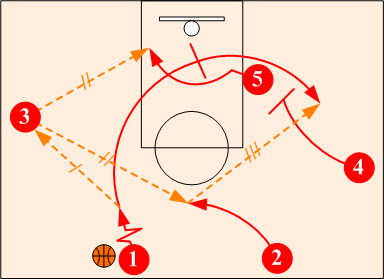
What to Discover or Recall . . .
Posting up is a big part of the game of basketball. It is truly an advantage to have a dominant force inside.
However, post ups are not limited to just big men, look for all teams to exploit size mismatches at any position.
Teams will commonly deploy the tactic of a small player setting a screen for a big player to create mismatches such is the case with the Base Cross offense.
The Base Cross Offense has been proven to be a highly successful on all levels of the game.We coaches have a tendency to make the game too complex. At first glance the Base Cross offense may look simple, but it's the execution of the baseline screen that is the key to making it so devastating. Basically, the point guard O1 initiates the base cross screen action with an entry pass to the wing O3 and makes a "Give & Go" cut to the basket. If not open on the basket cut, O1 continues and sets a strong baseline screen for O5. Post O5 comes off smaller O1's screen for a shot or a strong post up.
O1 after setting the baseline screen will continue out to the weakside wing off the weakside wing's down screen (or pop back up to the free throw line if the defense switches). When the wing O3 cannot feed O5, O3 makes a reversal pass out to O2 who, in turn, looks for O1 coming off O4's weakside down screen or O4 posting up strong.
Offensive Fundamentals Required
 Creating Leads - Proven Techniques to Get Open
Creating Leads - Proven Techniques to Get Open Setting and Using Base Screens
Setting and Using Base Screens Schematic Sequence

| Entries | Basic Reads | Post Options | Ball Reversal | Installing | Game Strategy | Case for Defense |

Phase 1. Entry
Various teams have adapted the Base Cross screen action to take advantage of their specific player personnel. Most of these variations are actually just variations as to which player sets the baseline screen.
Click on desired entry below to view illustrated counter option.
| Pass Entry | Dribble Entry | UCLA Entry | Hawk Entry |
Pass Entry
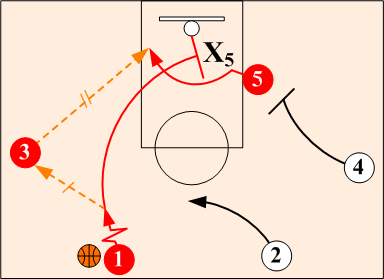
The point guard O1 initiates the base cross screen action with an entry pass to the wing O3 and making a "Give & Go" cut to the basket. If O1 is not open on the basket cut, O1 continues and sets a baseline screen for O5. Post O5 comes off smaller O1's screen for a shot or a strong post up. O1 after setting the baseline screen will either continue out to the weakside wing off the power forward's down screen or pop back up to the free throw line if the defense switches.
Dribble Clear Entry
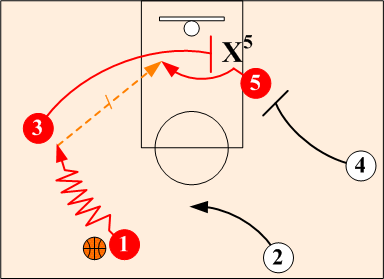
Point guard 01 dribble clears the wing 03. 03 back cuts and then sets a baseline screen (small screening for big) under the basket for the post O5. O5 comes off O3's screen for a shot or a strong post up. O3 after setting the baseline screen will either continue out to the weakside wing off the power forward's down screen or pop back up to the free throw line if the defense switches.
UCLA High Post Rub Entry
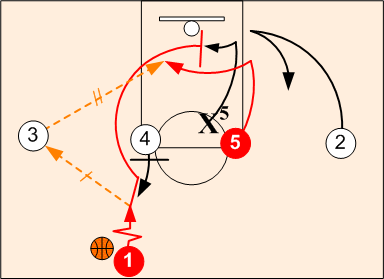
Using 1-4 high post alignment, the point guard O1 makes an entry pass to O3 and rubs off O4's high post screen. If not open, O1 continues and sets a baseline screen under the basket for O5. O5 comes off O1's screen for a shot or a strong post up.
Hawk Entry

Using the Hawk alignment, the point dribble penetrates down sideline as the off guard O2 cuts off O4's high post screen. If not open, O2 continues and sets a baseline screen under the basket for O5. O5 comes off O1's screen for a shot or a strong post up.


Phase 2: Execution of the Baseline Screen
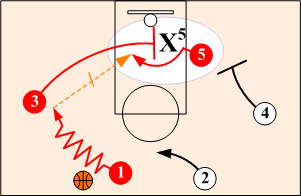
"It's not what you run, but how you run it that counts." The success of any offense is dependent on precise execution. In the Base Cross Offense, it is important for the screener to set a solid baseline screen, and equally important for the receiver to set up and use the screen.
Basic Reads and Counters. What if the....
Click on desired entry below to view illustrated counter option.
Defense SWITCHES on the base screen?

Smaller defender is MISMATCHED INSIDE against post.
Bigger defender MISMATCHED OUTSIDE against quicker ball handler.
Read: Defender Trails Screener
Counter: Back Cut

On O1's dribble clear action to the wing, if defender X3 should over play or trail O3 on back cut, O1 looks to feed O3 for open layup.
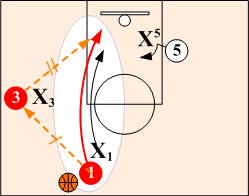
On the ballhander O1 pass to wing, if defender X1 should trail O1 on "Give & Go" basket cut, O3 looks to feed O1 for open layup.
Read: Post Defender X5 Plays Low
Counter: Go Top (Over)
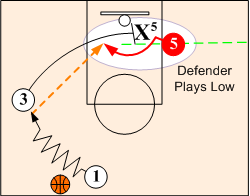
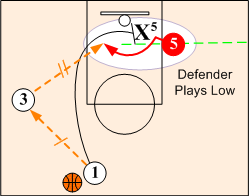
Go Over. When defender X5 plays low to the baseline side of O5, O5 takes X5 low to set up O3's screen and then breaks over the screen for shot or strong post up.
Read: Post Defender X5 Plays High
Counter: Go Base (Under)
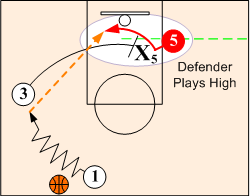
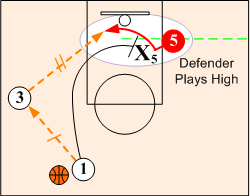
Go Under. When defender X5 plays to the high side of O5, O5 takes X5 high to set up O3's screen and then breaks under the screen for shot or strong post up.
Read: Defensive players SWITCH on the screen.
Counter: Screen and Pop
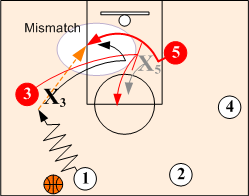
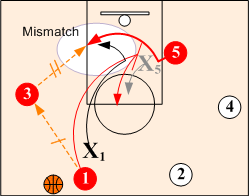
Mismatch Inside
When the defense switches on the base screen, O3 breaks up to the free throw line and O1 looks to feed post O5 posting up against the smaller defender X3.
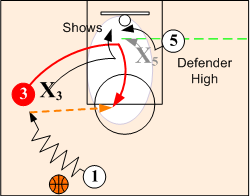

Outside Mismatch
Against the defensive switch, when O3 has a definite advantage over bigger X5, O5 clears out allowing O3 to go one on one against X5 from the free throw line. If/when O3's shot is not available, post can then dive to the basket to exploit smaller X1.
Defensive players "SHOW & RECOVER"
Counter: Screener Slips & Cuts to Basket
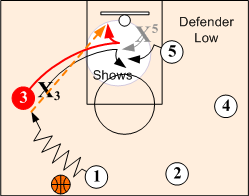
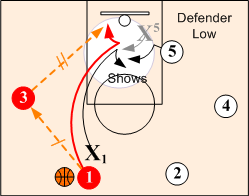
Slip. When defensive players X2 and X5 anticipate switching or "Show & Recover" on the base screen, screen O3 should fake the screen and slip (cut away) to basket for shot.
Read: Defender Fronts Post
Counter: Post Lob Option

Lob Pass. When the defense X5 assumes a full front denial position on the post, the post should force the defense out away from the basket, seal off the defender, and give the passer a target with the baseline hand. Passer should make a pass just over the top of the fronting defensive player.
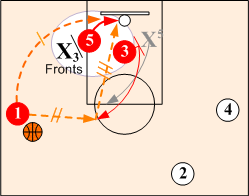
Ball Reversal option. Against the post front, the O1 also has the option of making a reversal pass to O3 breaking up to the free throw line for a better passing angle into the post.


Phase: 3 Posting Up Strong
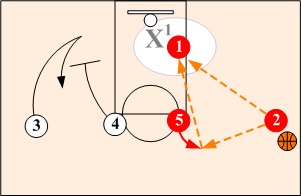
For the Post Isolation to be effective, physical size alone is not enough, players posting up must be well schooled in the basic post moves. In addition, both the passer and post player must be cognizant of the location of defensive player. Long time coach and present Laker assistant, Tex Winter, has not only brought the importance of court spacing along with the Triangle Post offense into the game, but he has also coined the phase "line of deployment" which assists players and coaches in "reading" and countering defensive post deployment.
View Basic Post Up Reads & Counters - Click Here

Low Post Two Person Game: Solo Cut Options

In addition to one-on-one isolation in low post area, the Post Isolation set readily flows into two-on-two action. The wing can initiates the two person game simply by feeding and cutting off the low post.
View Low Post Solo Cut Options - Click Here

Basic Low Post Split Options
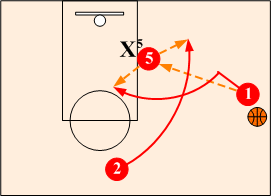
In the past, post splits were a staple in the vast majority of offenses. Although, their use has waned in recent years, post splits remain a very potent weapon for creating easy and open shots. On post splits whoever feeds the post cuts first.
View Low Post Split Reads & Counters - Click Here
Note: Both cutters clear out if they do not receive the ball allowing the post to isolate one-on-one against defender X5.

Phase 4. Ball Reversal Options
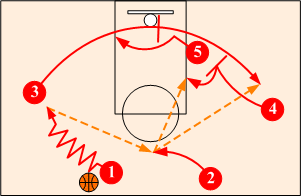
When a good shot is not available off the base screen action, the Base Cross Offense can flow directly into a quick hitting weakside down screen.
Weakside Down Screen
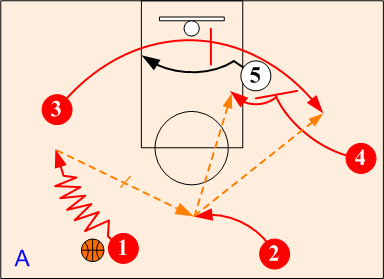
After setting the baseline screen, O3 continues out to the weakside wing off O4's down screen. O1 makes a reversal pass out to O2, who in turn looks to pass to O3 curling off the down screen or to feed O4 rolling to the basket.
Mid Screen Option
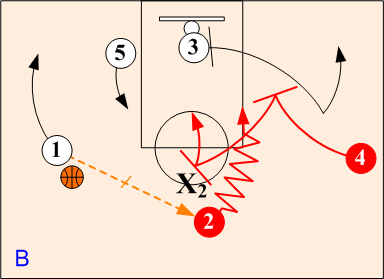
After setting or faking the weakside down screen, O4 can step out and set a mid screen for O2.
Side Screen Option

After setting the weakside down screen, O4 also has the option of stepping out and setting a side screen for O3.
Read: Reversal Pass Denial
Counter: Automatic Back Cut
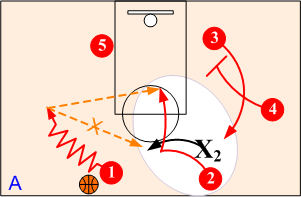
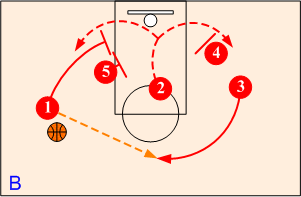
If defender X2 overplays and denies the reversal pass, O2 back cuts to the basket looking for a quick feed from O1. O3 replaces O2 on back cut. When O2 does not receive a pass from O1 on back cut, Single/Double screen action can take place.

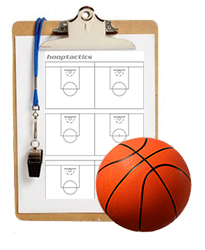
Teaching & Implementing the Base Cross Offense
The key to the success of the Base Cross Offense is in its execution and coordination. Players need to be well prepared to execute base screens, posting up strong, and down screens. In addition, players have to think and function as one unit. This requires proper defensive recognition, non-verbal communication, timing and experience.
Caution: Before undertaking any offense, players must have a solid, working knowledge of all of its components.
Mid Screen Breakdown Drills:
 Two Player Entries Drill (2-on-2)
Two Player Entries Drill (2-on-2) 3-on-3 Base Cross Screen Combination Drill (Entry, Base Screen, & Ball Reversals)
3-on-3 Base Cross Screen Combination Drill (Entry, Base Screen, & Ball Reversals)The Game Within a Game
Individual offensive skill development and improvement should be an integral part of every practice. In addition to early time (before practice) work, each player should, personally, have one or two individual fundamental techniques to work on during the course of a practice. The specific skill or skills will vary from player to player and can be assigned by the coaching staff or determined by the players themselves. As a reminder, the skill(s) should be written down on a 3 X 5 card and give it to each player prior to practice.

Game Strategies
Scout your opponent. Players need to know what reads to expect during the game. Opponents will generally use only a primary and secondary defense technique in defending screens and post ups. Educate and explain the anticipated reads and their counters. When scouting is not possible, scout your opponent during the game.
Don't be a spectator and watch the ball during the game. Be conscience and alert to any defensive changes or adjustments, especially after substitutions and timeouts. Don't hesitate in deploying various alignments and entries during the game so that defenders cannot focus on defending just one set. Move players around and attack the weakest defenders.

The Case for the Defense
Even if you do not plan to use the Base Cross Offense, you better be prepared to defend against it. It is one of the most used offenses to isolate a good low post player.
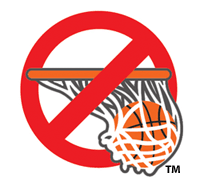
Continue and learn proven ways and techniques to disrupt the Base Cross Offense
Return to Set Offenses - Click Here
Return to Offensive Strategies - Click Here
Return to HoopTactics - Click Here
© 2026 HoopTactics All Rights Reserved.
